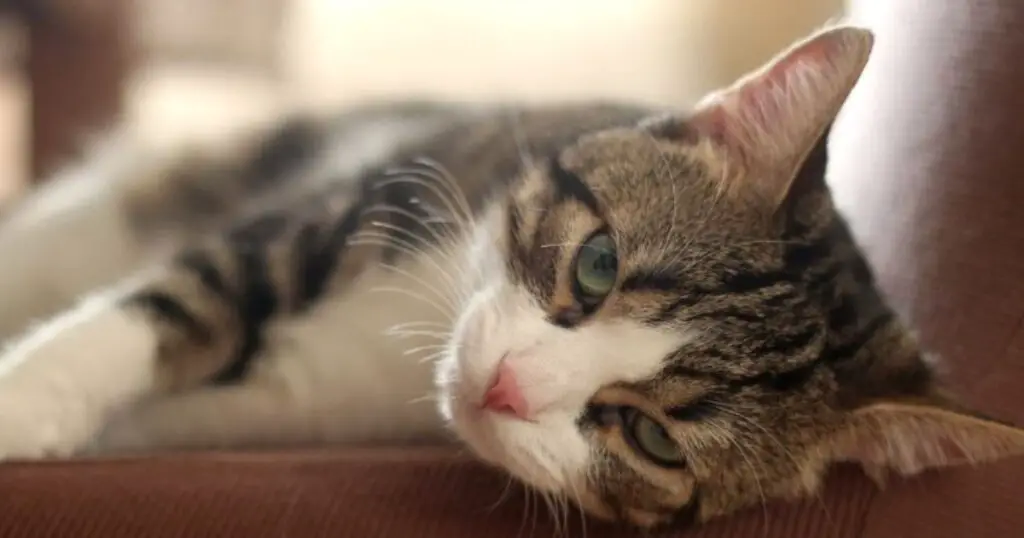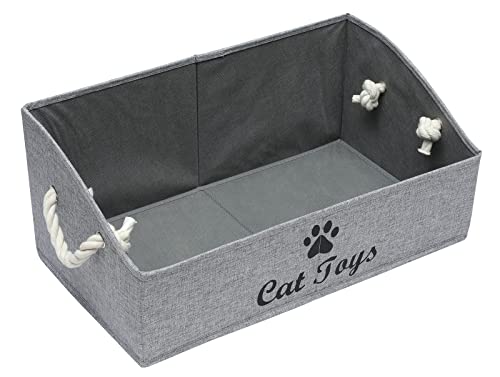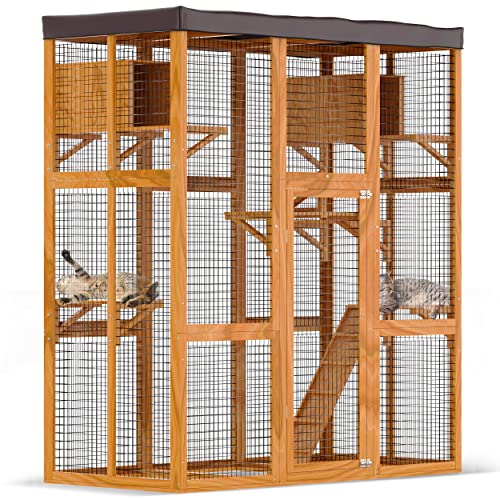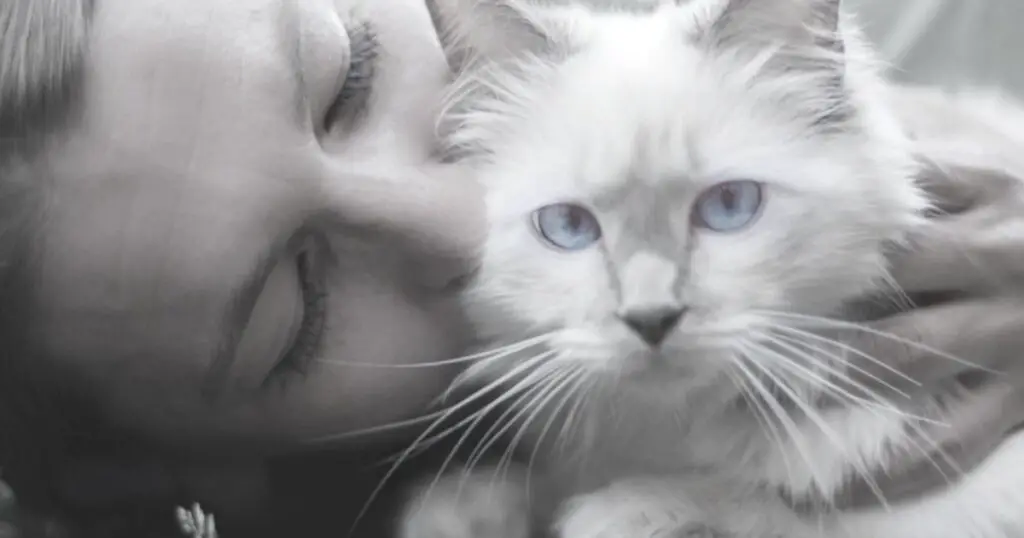Here are 26 tips for cat owners on how to look after indoor cats! These tips can help you give your cats happy and healthy lives.
There’s always a debate in cat owner circles about whether cats should be keep indoors, outdoors or a mixture of both. However, with the right care, there’s no reason why indoor cats can’t have the same rich lives as cats who roam.
1. Keep The Litter Tray Away From Their Food Area
Cats can be fussy when it comes to their food area and their toilet area. If those two areas are too close to each other, your cat may refuse to use one, or both.
Cats are fussy creatures. If they don’t like something, they’ll let you know.
If your cat’s litter tray is placed too close to their food area, they may have a problem with it.
It’s best to keep the litter tray away from their food area because cats are fussy and don’t like their toilet being too close to their food.
You can also try placing a scratching post next to the litter tray so that your cat can scratch off their claws before going for a toilet break.
To be fair now, you can’t blame your furry friend for this behavior. Would you like it if you had to eat your dinner next to the toilet?
2. For Multi-Cat Households, Consider 2+ Litter Trays
If you have more than one cat in your household and are wondering about the best way to deal with their litter box needs, you may want to consider a multi-litter tray system.
By doing so, you can provide each cat with their own space for relieving themselves without bothering each other.
The first thing that you need to do is decide on how many trays you need. This will depend on the number of cats that share your home and how many they are willing to share one tray with.
If you have three cats who are happy sharing a single tray, then two trays should be enough for your household — one for each cat. If there are five or six cats who want their own space, then three or four trays will probably suit your needs best.
Once you know how many trays you need, it’s time to decide where they should go. You could place them all in one area of your home or spread them out across different areas.
The key is finding an area that is easy for both humans and felines alike — preferably somewhere that has good ventilation and easy access for cleaning purposes (such as laundry rooms).
3. Invest in an Automatic Cat Food Dispenser (for dry food)
If you’re a pet parent of an indoor cat (or cats), you know that feeding your cat a healthy diet is important. But it can be difficult to make sure your feline friend is eating the right amount of food each day and that they are getting the nutrients they need.
It’s even harder if you’re out and about running errands when your cat/s are at home.
Automatic cat food dispensers can help you when you’re out at work, school or out with friends without feeling guilty about your cat being stuck at home without food.
You can programme it to feed your cat/s periodically throughout the day when you’re out or sleeping. We all know that cats love to eat at 5am and they’ll pester us for it until we wake up!
Dry Food Only – If your cat only eats dry food, consider buying an automatic feeder that will dispense dry food only. Wet food can get spoiled quickly, so even with an ice pack it may not be very pleasant for you (or your cat) if their food goes off.
Size Matters – A large kibble size may prevent smaller kibble from being dispensed by an automatic feeder. If you notice that your cat isn’t getting enough food from his current feeder, try switching to one with a larger kibble size or purchase two different sizes (one for small cats and one for big cats).
4. Consider Planting Some ‘Cat Grass’
If your cat loves to nibble on grass and plants, you can give him something that’s safe for him to eat by planting some cat grass indoors. Cat grass is a type of wheatgrass that cats enjoy nibbling on and it comes in several varieties.
Many plants are dangerous for cats, they can cause an upset stomach or even blood poisoning (which can be fatal).
Cat grass is available at pet stores and online, but you can also grow it at home. Follow these steps to grow your own cat grass:
Find the Right Location
Cat grass is an annual plant that grows easily in most climates. It can be planted in full sun or partial shade, but it thrives best if you plant it in a spot where there is no foot traffic or where it won’t get trampled by people or pets.
Windowsills are a great spot for cat grass.
Prepare the Soil
Cat grass needs soil that drains well so that it doesn’t get waterlogged and drown out the roots. You should also keep the area free of other plants so that they don’t compete with your cat grass for nutrients, water and sunlight. Till or spade up the soil so that it’s loose and fluffy before planting your seeds or seedlings.
5. Put a Scratch Post in Each Room
Cats need to scratch. It’s how they mark their territory, stretch their muscles and build up their claws. But scratching the furniture is not a good idea.
To keep your cat from scratching the furniture, you need to provide them with an alternative — something they can scratch that won’t ruin the couch or other pieces of furniture in your home.
One way to do this is by providing multiple scratch posts for your cat in different rooms of your home. This way, if one becomes damaged or starts to look worn, they have another one to use instead!
So what kind of post should you get? You want something that is sturdy enough for your cat’s size but also lightweight enough so it doesn’t get knocked over easily.
You also want something that has different textures or colors on it so it can be interesting for you and your cat and not just another boring piece of wood sticking out of the wall.”
6. Protect Soft Furnishings with Blankets or Throws
If you have a cat, you know that they can be quite destructive. They love to climb and jump on furniture, scratching and clawing at anything they can reach. This can lead to costly repairs and even ruined furniture.
If you want to protect your expensive sofa or chair from damage caused by your cat, there are several things that you can do.
You can protect your soft furnishings is with inexpensive throws or blankets. You can put throws over chairs and sofas that have been scratched by cats in order to hide any damage that has been done.
If you have an older couch or chair that is already showing signs of wear due to scratches, this would be an easy way for you to conceal them until you are ready for new furniture.
If these options seem too time consuming or inconvenient for whatever reason, consider getting a cat tree or condo for your feline friend instead!
Also – put away all loose items before going out – Cats will try their best to get into any open bag or box that contains something interesting for them! So make sure all loose items are put away before leaving the house with your cat in tow.
7. Invest in a Cat Drinking Fountain!
Cats like water that is fresh and flowing. Cats are very curious, so they will investigate anything new in their environment. A drinking fountain is a great way to keep your cat hydrated, but it also provides something fun for your cat to do.
If you have more than one cat, you may want to consider purchasing a drinking fountain that has multiple bowls. This will allow each cat to have their own bowl while still being able to get a drink from the other bowls.
Cats are creatures of habit, so it’s important not to change the location of your cat’s water bowl too often. Cats can be very sensitive about where their food and water is located, so try to keep it where it is unless there is a good reason for changing its location.
Make sure your cat has access to plenty of fresh water at all times by using one of these many funky pet fountains for your cat!
8. Keep an ‘Open Toybox’ for your Indoor Cats
One of the easiest ways to create a cat toybox is by keeping an open box of toys near your pet’s bed or favorite hiding place.
This way, when your cat gets bored or wants to play, they can simply find something to do on his own.
I’m sure you know that cat’s love to peer into boxes, this adds some extra fun to their play time.
You can even leave some of their favorite toys in there so that he always has something to play with.
Cats have different preferences when it comes to toys, so it’s important that you provide them with a variety of options so they can choose what works best for them at any given time.
For example, some cats prefer interactive toys while others prefer simple ones like balls or mice. It’s also important that you keep track of what types of toys your pet likes best over time so you can adjust accordingly if necessary.
9. Avoid Leaving ‘Human Food’ Out
A cat’s digestive system is not designed to process human food. Although it may look like your cat wants to eat everything including your dinner, this is not a good idea.
Your cat’s digestive system is designed for eating meat, which they get from cat food and provides all the nutrients they need.
If you want to give your cat something other than their regular food, try putting some tuna in a bowl or treat them with dry cat food that has been soaked in water.
However, avoid leaving human food out as the cat will try to eat it and it might be dangerous for them.
Cats are curious and they will naturally be attracted to different types of food for a sniff and a nibble. My cats are terrible for doing this with mayonnaise, porridge and cereals.
Even though cats love lapping up cow’s milk, it’s actually quite bad for them and can make them sick.
If you are concerned about your cat’s health or weight, please speak to your vet who can advise you on feeding requirements based on their age and activity level.
10. Be Very Careful with House Plants
If you have a cat and want to add some greenery to your home, it’s important to be very careful with house plants.
While many people assume that cats don’t like to eat plants, the truth is that some cats do. In fact, some research indicates that indoor cats may be more likely to eat house plants than outdoor cats.
One reason for this could be that indoor cats often lack exercise and therefore are more prone to boredom and frustration. Eating plants is a way for these cats to relieve stress and anxiety — especially if they don’t have access to other forms of entertainment.
Another reason could be that indoor cats’ diets are often different from those of their outdoor counterparts.
Many indoor cats receive all or most of their nutrients through dry food instead of fresh food. This can lead them to crave other sources of nutrition, such as fresh leaves and stems from houseplants.
11. Leave Blinds/Curtains Open for your Cats to Look Outside
Cats are natural hunters, and they need to see what’s going on in their environment. If you leave blinds/curtains open for your cats to look outside, they will be able to do so without leaving their hiding places. This is especially useful for indoor-only cats who have never been outdoors before.
If you want your cat to get used to looking out the window, hang a toy just outside so that the cat must stand up on her hind legs to reach it. This will help her become accustomed to standing in front of the window without having to jump up high.
If you have a cat who is afraid of loud noises or sudden movements, try putting treats near the window so that he has something else besides a loud noise or sudden movement to focus his/her attention on once he gets used to standing there.
It’s also a good idea to keep some toys in front of the window so that if your cat does decide he wants out, he has something fun and interesting on which to focus their attention rather than just staring blankly out at nothingness.
12. Check out “Cat TV” on YouTube!
Cat TV on YouTube – There’s nothing more entertaining than watching your cat watch TV! The great thing about this option is that it doesn’t cost anything except for the time it takes for you to set up the device and choose a video to play.
If your cat likes moving images, try playing a nature documentary or an animal show. If he prefers something quieter, try a baking show or cooking show with loud music in the background (and maybe even turn up the volume a little bit).
13. Create a ‘Safe Zone’ for your Indoor Cats
Create a “safe zone” for your cats to retreat to if they’re scared or just want some peace and quiet. A good place for this is in a room that doesn’t have much traffic, such as a basement or spare bedroom. This room can be decorated with cat-friendly items such as cat trees, scratching posts and toys.
Cats like their privacy, so give them places where they can hide if they want to be alone — under the bed or behind curtains are good options. If possible, leave some windows open so they can go outside when they want fresh air or sunshine on their faces.
If you have more than one cat, give each one its own space where it can feel safe and comfortable by itself. You can even separate them into different rooms if needed!
14. Consider an Indoor Cat Tracker (especially if you have a large house)
If you have a large house, or even if you have a small house, it can be difficult to keep track of your cat when they go exploring. The best thing to do is to get an indoor cat tracker for them for your peace of mind.
Cats can hide in nooks and small spaces, under beds, in basements, lofts, at the back of closets and all sorts of strange places.
There are many different types available and they range in price. You can also purchase a collar rather than an attachment that goes on the collar. They all work on the same principle, though: they use GPS technology to track your cat’s location and send it directly to your phone.
If you want more information about how they work, check out our article on indoor cat trackers.
15. Be Aware of Open Windows
If you want to stop your cat from going outside, you need to be aware of open windows.
The best thing that you can do is make sure that all of the windows are closed at all times except when they’re being used by humans.
But you must by disciplined with yourself and remember to close them afterwards or your cat will want to explore!
See also: Why is my cat being so clingy?
16. Consider Allowing Your Cat Outside
This really does depend on your living situation and the type of home/apartment you live in.
You may have heard that cats are safer and happier inside.
But, if you’re a cat lover and your pet is healthy and socialized, there’s no reason you can’t consider letting him or her outside. There are some important things to keep in mind when making this decision, however.
A cat who is allowed to roam freely outside can get into trouble more easily than one who stays indoors all the time. If you think that’s an issue for your cat, then it might be best to keep him or her inside.
Cats are very curious animals, so if something looks interesting or smells interesting, they want to explore it—whether it’s a tree branch or a bird feeder. They could even be hurt by the way an outdoor environment impacts their health and safety.
Make sure you have insurance, vaccinations and regular health checks for any cat who goes outdoors regularly. You also need to be extra vigilant with flea and worm treatments.
17. Build a Cat Porch for Indoor Cats to Explore
If you want to let your cat enjoy fresh air without exposing him or her to the elements, build an indoor/outdoor cat porch. This will give your cat a safe place to play and explore.
Cat porches are a great way to give your cat their own outdoor area to explore, play and relax. They can be built anywhere in the yard and can include everything from a simple wooden perch to a full-blown cat house with running water, electricity and even a bathroom!
18. Look into Cat-Proofing your Back Yards and Gardens
If you have a fence in your backyard, make sure there are no gaps in between it and the ground. This is because cats can squeeze through small spaces. You can also try using a netting or other material to cover the fence itself.
Make sure that the bushes around your house have no sharp or dangerous thorns or branches. If there are any, trim them back so that no one gets hurt when they play outside with their kitty friends.
If you have any trees in your yard, make sure that they aren’t too low for your cat to climb up on easily. This will help prevent them from jumping onto roofs or balconies and falling off them accidentally, which can be very dangerous for both humans and cats alike!
19. Make Sure Your Indoor Cat is Microchipped
You should get your indoor cat microchipped in case they manage to get out.
The tiny chip, which can be implanted in your pet’s skin between the shoulder blades, contains a unique number that can be read by an electronic scanner.
These days, most shelters and vet offices use scanners to quickly find out if a lost cat has been found. If they do, they can contact you right away.
Even if your cat never goes outside, it’s important to make sure it’s chipped. That way, if it accidentally escapes through an open door or window and wanders into someone else’s yard or gets hit by a car on the road, you’ll have a better chance of getting him back home safely.
20. Stay Up To Date With Routine Veterinarian Visits
Cats are generally very self-sufficient and can avoid a trip to the vet’s office for quite some time. But, they do need to be seen by a veterinarian at least once a year to make sure they’re healthy.
Your cat should be examined by a veterinarian at least once a year. A physical examination will allow your vet to check your cat’s overall health and identify any problems that may be occurring. This is also an opportunity for your vet to discuss any concerns you might have about your cat’s behavior or health.
In addition to a physical exam, blood work is often recommended for cats over 7 years old and for all cats with chronic disease, such as diabetes or kidney disease.
Blood work is also vital when diagnosing diseases like hyperthyroidism (overactive thyroid), hyperparathyroidism (excessive calcium in the blood), and lymphoma (cancer).
21. Keep up with Flea & Worm Treatments
Fleas can cause discomfort to both people and cats. They can also transmit tapeworms and other diseases. If your cat has fleas, it’s important to get rid of them as soon as possible.
You may think that indoor cats don’t need flea treatments, but this isn’t necessarily true as in certain environments, fleas may even jump from your clothing to your cat!
There are several different types of flea treatments available for cats, including topical applications and oral medications. These treatments can be purchased from your veterinarian or at pet supply stores such as Petco or PetSmart.
The most common topical applications are sprays or powders that kill fleas on contact with the skin or coat. Most of these products will kill not only adult fleas but also flea larvae and eggs, which are harder to reach with other methods of treatment such as vacuuming or carpet cleaning.
These products work best when used in conjunction with other products like oral medications or collars that prevent re-infestation by killing adult fleas before they have time to lay eggs that hatch into larvae later on in their lives cycle.
You also have to treat your home – spray carpets and soft furnishing as flea larvae and eggs can live in carpets for up to a year. It’s important to vacuum regularly.
22. Closely Monitor Your Cat’s Diet
If you have an indoor cat, you should be monitoring their diet and how much they’re eating.
Cats are generally pretty good at regulating their own intake of food, but they can become overweight if they’re allowed to eat as much as they want.
Indoor cats are less active than outdoor cats, so they tend to burn fewer calories. Because of this, their bodies store fat more easily. This can lead to weight gain over time if an indoor cat isn’t monitored closely.
It’s important to make sure that your cat always has access to fresh water and food at all times. If a cat doesn’t have access to water or food for even a short period of time, it can be very dangerous for them.
23. Get Your Cat Spayed/Neutered
There are several reasons why you should get your cat spayed or neutered.
The most important reason is to prevent unwanted kittens. Kittens can begin breeding as early as 4 months of age, and they will continue to mate throughout their lives.
If your unaltered cat gets outside, it can be very difficult to keep him from mating with a female cat in heat, who may already have a family of her own.
There are too many stray and feral kittens than there are homes for them. Don’t add to the problem by creating more kittens!
A second reason is that altering has significant medical benefits for both males and females. For females, the risks associated with pregnancy and birth are eliminated. For males, testicular cancer is prevented in addition to other medical problems that occur only in unaltered animals.
A third reason is that altering your pet will make them less likely to fight with other cats or dogs in the neighborhood.
The hormone changes caused by spaying or neutering make cats less aggressive towards other cats, and they tend not to spray urine in order to mark territory (a behavior which is not appropriate inside).
Learn how to get rid of the smell of cat pee in your house.
24. Get Insurance for your Indoor Cats
Indoor cats need pet insurance.
Your cat is a member of the family, so it’s important to protect them with pet insurance.
Indoor cats are just as vulnerable to injury and illness as their outdoor counterparts. They can get hurt by trips or falls, or even by playing with other pets. Cats may also develop chronic health conditions like diabetes or arthritis that require medications and regular vet visits.
Caring for your cat isn’t always cheap, so it’s important to have pet insurance to help pay for these expenses.
By choosing pet insurance for your indoor cat, you can be sure they’re protected against unforeseen accidents and illnesses that could cost thousands of dollars without coverage.
25. Always Make Sure their Food & Toilet Areas are Clean
Cats are clean animals and they like to keep their home clean too. Cats have an amazing sense of smell and can detect any odor that is not pleasant to them.
They will find it very difficult to eat food or drink water in a dirty area. This is why you need to make sure that your cat’s food and toilet areas are clean at all times.
It’s also important for you to keep your cat’s litter box clean so that the smell does not attract other cats into your house.
If you notice that your cat does not like something about his toilet area, then you should make sure that whatever it is gets changed as soon as possible.
26. Never Ever EVER De-Claw Your Cat
De-clawing a cat is cruel, harmful and dangerous and you should never do this.
De-clawing has been banned in many countries including the UK, New Zealand and Australia – yet it is shockingly still legal in some parts of the US.
The procedure involves removing the first phalanx (the end part) of each toe on each paw. It can be extremely painful for the cat, which often tries to bite its owner during de-clawing surgery.
The cat will also be in pain afterwards because the surgery causes infection of the bone and tissue surrounding the nail bed – which can lead to an abscess under the skin or pus around the nail bed.
This can cause a lot of pain as well as making it difficult for cats to walk normally for months afterwards. De-clawing also causes nerve damage which can result in chronic pain for some cats.
Cats who have been de-clawed may even resort to biting more.
For humans – it’s like having your whole fingertips removed, a cats claws are so much more than just sharp fingernails.
Looking After Indoor Cats: Conclusion
In the end, there are various things you can do to make sure that your indoor cats are happy and healthy.
Remember that your cat has different needs than an outdoor cat, and while they may not be as spectacular as those found in other animals, they should not be overlooked.
Maintaining a consistent routine will help keep them happy while keeping their physical and mental health on track.
Last update on 2024-04-26 / Affiliate links / Images from Amazon Product Advertising API













